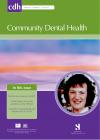Community Dental Health

- Cover Date:
- June 2012
- Print ISSN:
- 0265 539X
- Vol:
- 29
- Issue:
- 2
Compliance with school F-milk and non-F milk intake in 3 to 4 and 6 to 7 year old children
Background: Fluoridated (F) milk schemes are employed in six countries to reduce dental caries in children. To maximise their benefits considerable uptake is required. Measuring compliance and understanding contributing factors is important in evaluating the effectiveness of schemes since it can be unclear whether reported sub-optimal fluoride (F) intakes, measured through urinary F excretion, are due to sub-optimal F contents of milks or lack of compliance with consumption. Objectives: To determine compliance with milk consumption for children receiving non-F or F milk (containing 0.5 or 0.9mgF per 189ml carton) and rationalise the use of compliance data for clinical observational or intervention studies involving F milk schemes. Research design: Partially randomised, partial cross-over study. Participants: 50 children aged 3-4 and 6-7y consuming non-F (n=50) and F milk (0.5mgF; n=15 children; 0.9mg F; n=16 children) at school. Results: Mean compliance for both non-F and F milk was >90% in each of the groups studied and showed no statistically significant difference for children using both milks. The 95% central range of proportions of milk consumed for groups of individuals was wider for 0.9mgF milk (25% to 100%) than for 0.5mgF milk (81% to 100%) although the greatest range of variation in compliance for within individual observations was seen for non-F milk consumption and in older children. Conclusion: Assessment of compliance with consumption should be included when dental efficacy of F milk consumption is being investigated or evaluated to quantify F exposure from milk. This is important, particularly if a change in the F dose of F milk might be under consideration.
Key words: fluoridation, milk, child, preschool, schools
- Article Price
- £15.00
- Institution Article Price
- £
- Page Start
- 188
- Page End
- 192
- Authors
- R. Walls, V. Zohoori, L. Teasdale, D. Landes, I.N. Steen, P.J. Moynihan, J. Lloyd, N. Omid, A. Maguire
Articles from this issue
- Title
- Pg. Start
- Pg. End
- Dental Public Health in Action - The Platform for Better Oral Health in Europe Report of a New Initiative
- 131
- 133
- Effect of national recommendations on the sale of sweet products in the upper level of Finnish comprehensive schools
- 149
- 153
- A review of strategies to stimulate dental professionals to integrate smoking cessation interventions into primary care
- 154
- 161
- When Can Oral Health Education Begin? Relative effectiveness of three oral health education strategies starting pre-partum
- 161
- 167
- Clinical evaluation of three caries removal approaches in primary teeth: A randomised controlled trial
- 173
- 178
- Relationship between gingivitis severity, caries experience and orthodontic anomalies in 13-15 year-old adolescents in Brno, Czech Republic
- 179
- 183
- Prevalence of necrotizing ulcerative gingivitis and associated factors in Koranic boarding schools in Senegal
- 184
- 187
